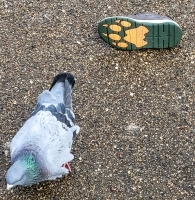Adam Yamey's Blog: YAMEY, page 96
March 5, 2023
Three Indian men in London’s Bloomsbury
MAHATMA GANDHI IS commemorated by a statue in Tavistock Square in London’s Bloomsbury. He is probably the most famous of three Indians with statues in Bloomsbury. Crafted by the sculptor Fredda Brilliant and presented by the Indian High Commission, it was unveiled by Prime Minister Harold Wilson in 1967.
The next most famous Indian represented by a sculpture in Bloomsbury is a Nobel Prize winner, the celebrated writer and polymath from Kolkata (Calcutta), Rabimdranath Tagore (1861-1941). The memorial depicts Tagore’s head. It was created by the sculptor Shenda Armery, and unveiled by the Prince of Wales, now King Charles III, on Tagore’s 150th birth anniversary year in July 2011. The bust stands in Gordon Square, close to University College London, where Tagore studied law briefly. His face looks away from the college towards the southeast. – towards India, his homeland. On one side of the plinth, there are some words written in Bengali script. On another side, there is a translation of this brief text (by Tagore) in English:
“Thou hast made me endless, such is thy pleasure. This frail vessel thou emptiest again and again, and fillest it ever with fresher life. This little flute of a reed thou hast carried over hills and dales and hast breathed through it melodies eternally new. At the immortal touch of thy hands my little heart loses its limits in a great joy and gives birth to utterance ineffable. Thy infinite gifts come to me only on these very small hands of mine. Ages pass and still thou pourest and still there is room to fill.”
This is from Tagore’s collection of poems – “Gitanjali”, translated into English from Bengali by the author in 1913. It was this collection that led to Tagore being awarded the Nobel Prize for Literature in 1913. In 1915, King George V awarded him a knighthood, but following the Jallianwala Bagh massacre of 1919, he renounced his knighthood to express his horror at the murders that had been perpetrated on innocent Indians by British troops in the Punjab.
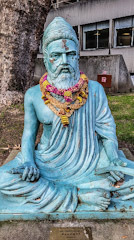 Thiruvalluvar
ThiruvalluvarCall me ignorant but I had never heard of Thiruvalluvar, whose bust stands in a garden next to the School of Oriental and African Studies in Bloomsbury. According to a plaque next to the bust, this man was author of “Thirukkural”, which was a classic of Tamil philosophy and ethics. The bust was donated by the Governent of Tamil Nadu in 1996, and unveiled by the then Indian High Commissioner Dr ML Singhvi. Celebrated as he is in Tamil Nadu, little is known about his life. It is possible that he was born or lived in Mylapore (now a district of Chennai) in the south of India. According to Wikipedia:
“His work Tirukkuṟaḷ has been dated variously from 300 BCE to about the sixth century CE.”
As for his great work “Thirukkural”, the online version of Encyclopaedia Britannica remarked:
“…Tirukkural (“Sacred Couplets”), considered a masterpiece of human thought, compared in India and abroad to the Bible, John Milton’s Paradise Lost, and the works of Plato.”
I have described monuments to three notable men from India, but omitted one woman, whose memorial is close to those already described. The WW2 heroine Noor Inayat Khan (1914-1944) is commemorated by a bust, which, surprisingly, I have never noticed, in Gordon Square. Sculpted by Karen Newman, it was placed in the square in 2012. This artist also sculpted a bust of Violette Szabo (1921-1945), which is on the embankment of the Thames near Lambeth Palace. Both Noor and Violette worked for the British SOE, and perished in Nazi concentration camps.
Once the epicentre of the British Empire, it is not at all surprising that one comes across memorials to notable Indians whilst wandering about in London and other places in the UK.
March 4, 2023
Seeing red
KAYAL ISLAND RETREAT is a small but tastefully luxurious resort on the east coast of the long thin Kakkathuruthu Island in the backwaters of Kerala, not far from Alappuzha (Aleppey). Our friend who owns it kindly invited us to spend an afternoon there. During our stay, we were taken on a delightful boat trip through the peaceful backwaters. After that, the resort’s manager took us on a walk through the rustic tropical landscape from the resort to a nearby small ferry landing stage on the west side of the island. We followed him along a winding path that threaded its way between small farmhouses, fields, fish farms, ponds, and reed beds.
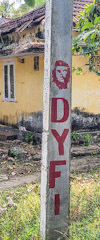
All along the path, there was a series of concrete poles that supported overhead electricity cables. On almost every one of them there was red painted graffiti. Many of the poles were daubed with the initials ‘DYFI’, which stands for the Democratic Youth Federation of India, which is affiliated to the CPI(M) – the Communist Party of India (Marxist). Some of the poles also had depictions of the head of Che Guevara and five-pointed red stars or the letters ‘CPIM’. One pole had “Viva Revolution” on it and some others were daubed with the names of countries including Mexico and Bolivia, At least one house along our route had a large hammer and sickle painted on it. With the exception of the country names, all of these manifestations of Communism are frequently seen all over Kerala, which at times has been ruled by Communist governments,
At the small ferry landing stage, we watched some women and schoolchildren disembark from the ferry – a small boat with an outboard motor. Overlooking the simple wooden landing stage, there was a tall metal pole with the letters BJP on top of it. The pole supported two cords from which BJP flags were fluttering. The BJP (Bharatiya Janata Party) is currently in power as the Government of India.
I asked our guide how the locals tended to vote on the island. He believed that most of them would probably vote for the Communists or some other Socialist party, rather than for the BJP. As we walked along in the hot humid air, I mused upon the contrast between the wealthy holiday makers enjoying our friend’s resort and the relatively poor inhabitants of the island with leftward leaning political sympathies, who might, in theory at least, be antipathetic to the idea of outsiders relaxing luxuriously on their island whilst they slog away in the hot sun. Whatever they believe, the resort does bring additional employment opportunities close to their homes – almost all the staff are from the island.
March 3, 2023
Art behind bars
FORT KOCHI IN Kerala was occupied by three European powers: first by Portugal, then ny the Netherlands, and then by the British until 1947. It was whilst the British were in charge that a small jail was built on what is now Tower Road. Next to a police station and close to a string of roadside seafood restaurants, there is a gate that leads into the Jail of the Freedom Struggle. This prison was built by the British at a forgotten date during the 19th century. One clue to its age is that some of its roof tiles can be dated to 1865. The prison has a row of eight cells, each equipped with a 6 foot long concrete bed.
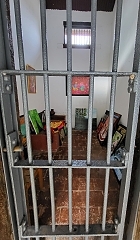
The prison, which might have been used as a transit establishment for prisoners waiting to be taken elsewhere, is said to have held leading freedom fighters such as Mohammed Rehman, Accamma Cherian, and K J Herschel, A K Gopalan, E M S Namboothiripad, and Abdurahiman Sahib. However, this is not known for certain. The prison, which had become disused and dilapidated, was restored in 2009, and opened as a museum.
In February 2023, we visited Fort Kochi to explore the 2022 Kochi Muziris Art Biennale. Unconnected with this major event, we visited an exhibition of artworks being displayed in the former prison. This included both paintings and sculptures. What made it an usual exhibition is that the exhibits are all contained within the cells behind strong iron doors with vertical bars. The doors that once prevented the prisoners from leaving the cells now prevent visitors from entering them.
March 2, 2023
Seen in Kensington Gardens
March 1, 2023
Women in art
SURVEYING THE REPRESENTATION of women by artists in a single exhibition might seem a daunting task, if not impossible. Yet, this is what the exhibition “Visible/Invisible” achieves successfully. Curated by Kamini Sawhney, Arnika Ahldag, Vaishnavi Kambadur, Riya Kumar and Arshad Hakim, this magnificent display of artworks can be viewed at the recently opened (in late February 2023) Museum of Art and Photography (‘MAP’) on Kasturba Road in Bangalore (Bengaluru). The exhibition, which is displayed in most of the rooms on one floor of MAP confines itself to works created by artists, both male and female, from the Indian subcontinent and its diaspora. However, this did not hinder the curators’ aim of demonstrating the female in art over the centuries.
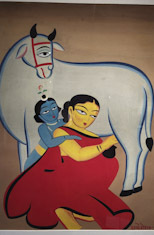
The 130 artworks on show range in date of creation from the 10th century AD to the present. MAP’s website reveals that the various artworks:
“… are interwoven into four key sections based on narratives and counter-narratives: Goddess and Mortal, Sexuality and Desire, Power and Violence, and Struggle and Resistance. Each section presents how women’s lives have been portrayed, the spaces that they occupy and challenges that women have faced in the Indian subcontinent. The themes and ideas explored in Visible/Invisible hopes to encourage audience awareness of the history and role of women and gender in art.”
And the exhibition successfully raised my awareness of the multiple ways in which the lives of women have been portrayed by artists of both genders over the centuries,
The artworks include sculptures, paintings, photographs, film posters, textiles (some created by female artists and others woven in traditional patterns by craftswomen), and prints. Almost every exhibit was a joy to behold, What was particularly interesting were examples of artworks created within the last few decades that demonstrate how Indian women artist have taken control of the way they portray women and their lives, What the viewer sees is how women see themselves, which is a contrast to what has happened in earlier times when women have often been shown in the way that men have viewed their lives.
All in all, this exciting exhibition is compelling both visually and conceptually. The curators have expressed their ideas beautifully and powerfully, but not without considerable subtlety.
February 27, 2023
A masterful academic qualification
MANY INDIANS STRIVE to gain a Master of Business Administration (‘MBA’) degree. I can say little or nothing about the merits of this academic qualification, but know many friends who have been awarded it.
A long time ago, soon after we married in Bangalore, we attended an engagement party held for one of our friends. During the evening, the priest who would eventually officiate at the marriage gave a speech. He spoke in English with a strong South Indian accent. He introduced the couple as follows:
“These two dear people are well-matched. He has a yem bee yay. And she has a yem bee yay…”
Just in case you did not make sense of that, ‘yem bee yay’, it is the way that many Bangaloreans would pronounce ‘MBA ‘.

This distant memory of our friends’ engagement party was prompted by noticing a tea shop on Bangalore’s St Marks Road. It is named “MBA CHAI WALA”. Above the name are the words “India’s Most Iconic Chai Wala”. As we were in a hurry on our last day in Bangalore, we had neither the chance to sample a cup of tea nor to discover whether the place had anything to do with the MBA degree. On our next trip to Bangalore, I will investigate and get back to you.
February 26, 2023
A new museum on the map
THE MUSEUM OF ART and Photography (‘MAP’) in central Bangalore has just opened (on the 18th of February 2023. Facing the Visvesvaraya Industrial & Technical Museum, MAP is housed in a brand new building with some attractive architectural features.
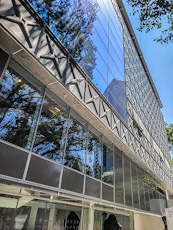
The edifice has five floors and a basement, which is home to an exorbitantly priced café, run by a company called Smoor. The ground floor has a reception area, a book/gift shop, and some gallery space. This is currently housing an exhibition of fascinating, attractive sculptures by LN Tallur. Some of the works of this contemporary artist allude to Hindu deities in a novel way.
The first floor is home to an auditorium, named after one of MAP’s major donors, Mazumdar-Shaw. Kiran Mazumdar-Shaw, a childhood friend of my wife, is a keen collector of art and has helped finance many other cultural establishments. On the same floor, there is a digital exhibition, whose subject matter can be chosen by the visitor.
The second floor is dedicated to offices and a library. Above this on the third floor, there is currently an exhibition of photographs by Jyoti Bhatt (born 1934), who began his artistic career in the famous art school in Baroda (Vadodara) in Gujarat. His works range from excellent straightforward documentary photography to highly creative artistic photography and collage work.
On the fourth floor, we enjoyed a beautiful exhibition called “Visible/Invisible”. Curated by Kamini Sawhney, Arnika Ahldag, Vaishnavi Kambadur, Riya Kumar and Arshad Hakim, this show explores the visual representation of women in artworks through the ages. Words alone can not do justice to the impactful nature of the display, but I will give you a rough idea of its range. In addition to paintings, modern and old, there are sculptures; photographs; tapestries,; traditional textiles; prints; and a video installation. Most of the artworks in this show were created by Indians or members if the Indian diaspora. The show successfully demonstrates how women have been portrayed over the centuries and how this has changed, especially more recently.
The fifth floor has a terrace from which there are some great views. There were some tables and chairs up there, but the café, if it exists, was not open.
Some years ago, we were in Bangalore when its branch of the National Gallery of Modern Art (NGMA) was opened in a restored palatial mansion near the Bangalore Golf Club. A beautifully designed annex was built next to the old building. When it was opened, I decided that it was a ‘must-see’ attraction in Bangalore. It remains so, but MAP in its newly constructed home will join NGMA amongst my suggestions of what should not be missed by visitors (and inhabitants) in Bangalore.
February 25, 2023
On a banana leaf
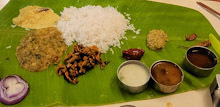
Lunch on a leaf
Eat it using your five fingers:
An Andhra thali
February 24, 2023
Three men and a trolley
One man pulls the trolley. Another stands on the trolley, pulling a lever back and forth. The lever operates a pump that sends water from a tank (on the trolley) along a hosepipe to a third man, who is holding its end and spraying the flowers.
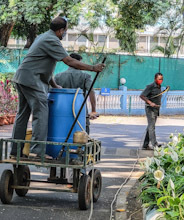
In India, there is no shortage of manpower and wages are not high. So, employing three men to do what a costly sprinkler system would do in Western Europe makes sense and gives employment to those who have families to feed.
February 23, 2023
Keeping on the safe side
IT IS ALWAYS WISE to ward off the Evil Eye. The Turks use characteristic amulets known as ‘nazar’. They are usually flat and almost circular with a design that resembles a stylised eye. This is now to seen on the homes of many people with no connection with Turkey. The Arabs and some Jewish people use an amulet, the ‘hamsa’, depicting a hand with five outstretched digits, to protect against the malevolent effects of the Evil Eye.

During road trips in India, I have often seen lorries (trucks) and other vehicles with thick, black, plaited tassels attached on the left and right sides of the driver’s cab. These things fly out sideways as the vehicles speed along.
One of our driver’s, the highly educated and informative Raheem, explained that these tassels are nazars. The drivers attach them to their vehicles to ward off the Evil Eye – an especially wise precaution on many roads in India.
During a recent (December 2022) visit to Panjim in Goa, my wife bought a couple of scarves from a female street vendor. The seller was so happy that my wife had bought from her that she immediately attached a bracelet on my ‘other half’s’ right wrist. The bracelet has a Turkish style Eye nazar and is made of black beads, which might well be designed also to protect against the Evil Eye.
Even more recently, I noticed that an autorickshaw, which we had hired in Bangalore, was adorned with two hefty black tassels just like those seen on lorries. I was struck by these because on the whole autorickshaws in the city do not have them.
I have one minor concern about vehicles whose drivers have attached things to ward off the Evil Eye. That is, I wonder whether the knowledge that their vehicles are equipped with such protection might drive more recklessly than those who do not put any faith in objects that might possibly have a protective value.

